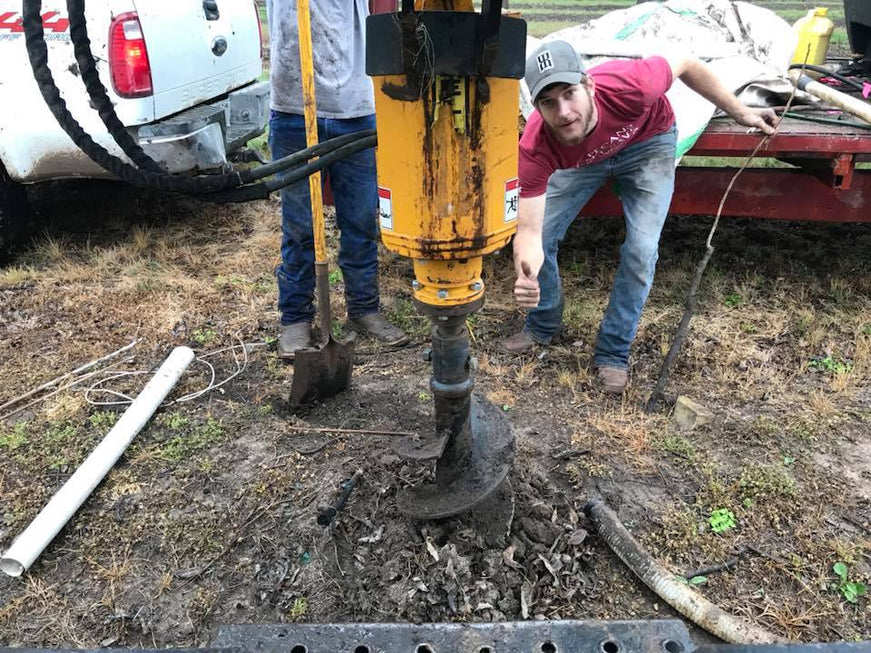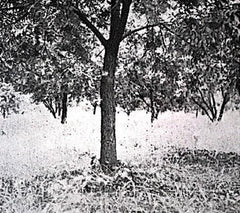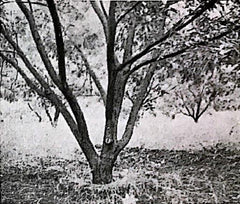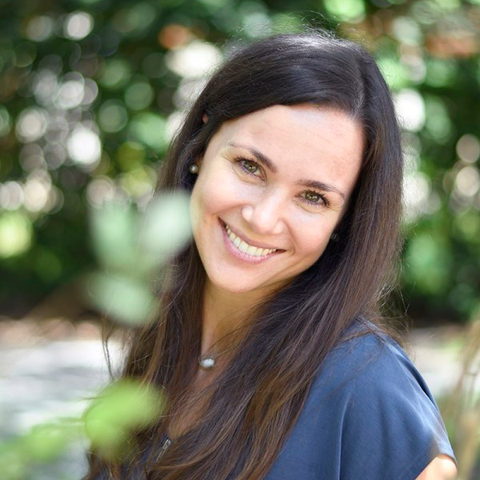
L. D. ROMBERG
Crops Research Division, Agricultural Research Division
U. S. Department of Agriculture
Brownwood, Texas
EVER SINCE the early days of pecan culture, a difference of opinion has existed as to the best way of establishing the trees. In far Western Texas, where rainfall is low and pecan trees are mostly along the banks of streams, the theory has developed that to do well a pecan tree needs a taproot extending far into the subsoil, and preferably to the water table. Associated with the theory, there has been a belief that if the taproot is cut, as in transplanting, the tree will never be quite as good as when never disturbed. Various other, and probably more important matters, are involved in the question: which is the best procedure tor planting a pecan orchard from the standpoint of financial success of the enterprise, planting trees or planting seed in place?
To obtain more information on the comparative performance of trees started by the two methods, similar experiments were set up in the winter of 1949-50 by Harris and Smith (1) at the U. S. Pecan Field Station, Shreveport, Louisiana, and by the writer at the U. S. Pecan Field Station, Brownwood, Texas. Results of the experiment conducted at Shreveport were published in the Proceedings of the Texas Pecan Growers Association for 1959. Here we describe the work done at Brownwood.
Experimental Plan
Trees and seed were planted on a tract of about 1 acre on the grounds of the U. S. Pecan Field Station. All around the outside, a border row was planted with 1-year old seedlings spaced 35 feet apart. The inside area was staked off in a pattern 17½ x 35 feet. Following a randomized arrangement, seed of the Riverside variety were planted at some stakes and budded nursery-grown trees of the Western variety at others. The trees had 3-year old rootstocks grown from Riverside seed nuts and 1-year tops.
A very hard early freeze in the fall of 1950 severely damaged the budded trees. These trees and the seeds were replaced in the spring of 1951 with the same kind of trees and seed. The seedlings in the outside border row were not replaced and thus were started a year sooner.
Thirteen budded nursery trees were planted. Of these, three were replanted the following year; and at one position it was necessary to replant a second time. Seeds were planted at 27 stakes and from them trees were obtained at 19 places. It was necessary to replant once at four stakes, twice at three stakes, and three times at three stakes. Thus, more difficulty was experienced in getting a stand of trees from seed than by transplanting. The trees started from seed in place and the transplanted seedlings were later grafted with scions of the Western variety. Thus, these trees and the budded nursery trees in time all had tops of the same variety on rootstocks grown from seed of the same variety. The trees developed from the trees and seeds replanted after 1951 will be excluded from the comparison of performance of the several groups of trees.
Some Known Facts
Before making a comparison of the three groups of trees in the experiment, it is helpful to consider some factors that are well known to affect the performance of a pecan tree.
1. Transplanting interrupts the growth of a tree since it necessitates re-establishment of the roots which the tree lost in the operation. If the tree is not properly cared for, it may become reestablished slowly, or may not survive. However, if one or more seeds are planted, there is also a possibility that none will become a permanent tree. The growth of a seedling likewise depends on care. If both a seedling and a normal transplanted tree receive proper care the transplanted tree will be larger in trunk circumference and extent of root system at the end of the first 1 or 2 years.
2. The relative growth rate of individual seedlings, or of named varieties, may differ considerably. For example, the Halbert variety Is a slow weak grower and Western is one of the stronger ones. It is believed that the growth rate of a grafted variety is affected by the growth rate of rootstock.
3. The height of the scaffold branches of a tree will affect the rate of increase in trunk diameter and branch spread. Less material is required to construct a short trunk than a long one of equal diameter; consequently there is more available to other parts of the tree.
4. Pruning has a retarding effect on the overall growth of a tree. Removal of low branches, as is done to get higher scaffold branches, affects the increase in trunk diameter. A topworking operation also has this effect.
5. Low-headed trees bear sooner than those headed high, but low branches often interfere with orchard machinery. Scaffold branches should begin at a moderate height to facilitate mechanical harvesting. Low branches also favor development of fungus diseases, and should be removed while small.
6. The taproot of a pecan seedling grows faster than the top during the first year of its growth, a proportion 1 that decreases greatly thereafter. The top of a young seedling tree is erect, with a strong central leader and few lateral branches, indicating strong terminal dominance in the buds. The leaves and shoots are pubescent, and at an early stage in development may show a red pigment. The hard dry protective bark is resistant to winter injury near the ground where grafted trees are susceptible to winter killing. After the first year, the pecan tree grows rapidly to compete with low-growing vegetation.
The shoots of seedling trees 10 to 15 feet high are not pubescent and pigmented, and under favorable conditions produce flowers. Such bearing shoots are said to be “mature,” while those of young, non-bearing seedlings are called “juvenile.” Differences between mature and juvenile shoots are thought to be due to amount and composition of growth regulating substances synthesized in the tissues.
Buds from mature branches placed on juvenile trees, as is done in grafting nursery trees, produce trees that bear sooner than seedlings, and they do not exhibit the morphological characteristics of juvenile trees. Such trees tend to develop a branched top, with large scaffold branches arising near the ground.
Because of the differences between juvenile and mature shoots, there are three types for planting a pecan orchard: (I) seedling trees started by planting seed in place, (2) nursery-grown seedling trees and (3) nursery-grown trees with grafted tops. The first two are alike in that both have juvenile tops; they differ only in that in (1) the roots are never disturbed, while in (2) the roots are disturbed by transplanting. The trees of (3) differ from those of (1) and (2) in that they have bearing tops.
Results of Experiment
At the end of 1965 differences were noted in the branching of the trees grown by the three methods. The trees from transplanted seedlings and from seed in place formed a strong erect stem, upon which a graft had been placed at a height of 5 feet. Scaffold branches developed on the grafted portion above the height. Thus, no further removal of low branches will be required in the near future. These trees are well suited to mechanical harvesting because the branches are high enough to permit easy threshing by one hook-up of the shaker to me tree, Figure 1a.
The budded trees, having "mature" tops, formed bush-like branches without a central leader. Scaffold branches developed near the ground making it necessary to attach the shaker to several on each tree for mechanical harvesting, Figure 1b.
a . b.
. b.
Figure I. Left, tree developed by grafting a seedling at a height of 4½ feet. Right, transplanted nursery-grown grafted free that was not pruned. Note difference as to adaptation for mechanical harvesting.
These trees have produced more pecans than the high-headed trees started as seedlings, but the lower branches are in the way of implements and should be removed. Pruning trees in Fig. 1b. to the same height of head as those in Fig. 1a. would greatly reduce their bearing tops. Earlier pruning of the budded trees would result in retarding top growth.
Data on the size of the trees of each group at the end of 1965 and increase in trunk circumference per year are given in Table 1. Average yearly increase in trunk circumference varied from 0.93 to 2.51 inches. This variation resulted mostly from differences in environment because spots of Johnsongrass and uneven irrigation. By contrast, differences between the average yearly increases of the three groups of trees were relatively small, varying from 1.70 to 1.91 inches. The method by which a tree was established was a smaller factor in the final size of the individual trees than the growth rate maintained after planting. However, on the average, transplanted trees were larger than those started from seed.
Discussion
Planting seed in place to start an orchard involves little cost at the beginning, but is not recommended because of the extra time and care required to get the seedlings up to the size of a transplanted tree. Usually more replanting is required to get a stand than when transplanting is practiced. The trees must be grafted later in place, but they eventually develop into excellent trees.
If nursery grown seedlings are chosen in preference to grafted nursery-grown trees, a saving in cost will be realized at the beginning but there will be an expense later for grafting in place. Whether the total cost of establishing the trees will be more or less than if grafted trees were purchased depends on availability of competent help and many other factors. The transplanted seedling tree is juvenile until grafted, the same as a tree started from seed in place. Such a tree may be preferable to a tree grafted in the nursery, provided the owner can handle the problem of grafting. Sometimes trees of a desired variety or size are not available from nurseries. Seedlings may then be planted and grafted to the desired variety after the trees are established.
Planting grafted nursery-grown trees avoids the problem of topworking seedlings in place, and progress of the trees is not interrupted. However, the nursery-grown grafted tree requires more pruning in succeeding years than those grafted in place to get high scaffold branches. Removal of low branches is necessary to allow free movement of farm machinery and reduce build-up of fungus diseases. If scaffold branches are developed near the ground, the trees will come
TABLE 1. Date and method of planting and size and average growth rate of trees in planting experiment, Brownwood, Texas at end of year 1965.
=====================================================================
Year of Method of No. years Rank in Trunk Average
planting planting growth size Circum- increase
ference per year,
inches inches
=====================================================================
1950 1-year 16 Largest 40.2 2.51
seedling
trees
-----------------------------------------------------------------------------------------------------------------
1950 1-year 16 Average 30.6 1.91
seedling
trees
-----------------------------------------------------------------------------------------------------------------
1950 1-year 16 Smallest 14.8 0.93
seedling
trees
-----------------------------------------------------------------------------------------------------------------
1951 3-year 15 Largest 37.3 2.49*
nursery
trees
-----------------------------------------------------------------------------------------------------------------
1951 3-year 15 Average 27.8 1.85*
nursery
trees
-----------------------------------------------------------------------------------------------------------------
1951 3-year 15 Smallest 16.5 1.10*
nursery
trees
-----------------------------------------------------------------------------------------------------------------
1951 Seed in 15 Largest 35.9 2.40
Place
-----------------------------------------------------------------------------------------------------------------
1951 Seed in 15 Average 25.5 1.70
Place
-----------------------------------------------------------------------------------------------------------------
1951 Seed in 15 Smallest 18.2 1.21
Place
-----------------------------------------------------------------------------------------------------------------
*The increase was slightly less than this figure because the circumference of the trees when planted was some 2 inches.
into production earlier than if higher; but they will be less desirable for mechanical harvesting.
Apparently a transplanted seedling develops the same kind of root system as one not transplanted. However, the replacement of a juvenile by a bearing top, as in grafting, may affect the root system and the overall growth of the tree. More experimental work is needed to determine if this is true.
Conclusion
This experiment shows that the growth rate after establishment is more important in determining the size of the tree than the method of planting.
Literature Cited
1. Harris, O. W. and C. L. Smith. 1959. Comparison of transplanted nursery trees and seedlings budded in place for establishing a pecan orchard. Proc. Texas Pecan Growers’ Assoc. 38:48-50.

